|
http://www.in2-mec.com/J-Pages04/J040515.htm
parts 1 - 2
- 3
New Delhi, India
15 May 2004
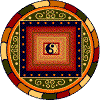 |
Pilgrimage to Shalagram (Gandaki and Muktinath)
Part Three
|
 |
Hare Krsna! All glories to Srila Prabhupada!
Again, if you wish to refer to a detailed map of the places shown in
today's photoreport, double-click this web address:
www.footprint-adventures.co.uk/mapnep/fixjoms.html
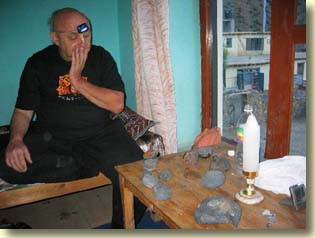 |
| Late sunset inside my room at the Hotel Hill Ton:
I'm contemplating the salagrama silas we've found today. On my forehead
is a trekker's lamp that I purchased in a shop in Pokhara. I used this
to study the silas closely. |
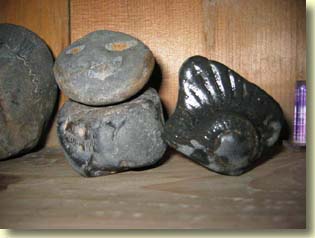 |
|
Here's evidence that the
Lord desires I continue to worship Him in the forms of Sri-Sri Jagannatha-Sudarsana.
I found a sila with the unmistakable features of Lord Jagannatha on the
face: two reddish eyes, a nose, and a smiling mouth. I've positioned this
sila atop the Sudarsana sila that I found this morning to form Lord Patita-pavana
(the name by which Lord Jagannatha is addressed when He is worshiped separately
from Baladeva and Subhadra). Positioned next to Patita-pavana is a second,
very beautiful, Sudarsana sila.
|
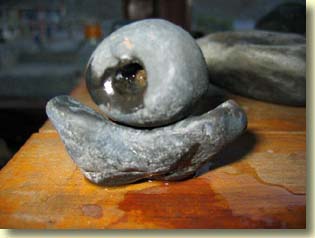 |
| Yajna-purusa is the name of this combination of silas.
A sila with an extraordinary mouth rests upon a Cakra sila of a wavy shape
like a flame. Sudarsana Cakra is the very form of the yajna fire (savana
tejas trayi), and the Lord personally appears within that fire to eat the
offerings of His devotees. |
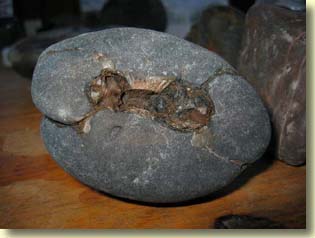 |
|
This sila I found was very
ugra, obviously a Nrsimha
with at least 2 cakras in His mouth. Elsewhere
on His
body were other fearsome markings. I returned Him
to
the Gandaki. Too heavy, in both senses of the word.
|
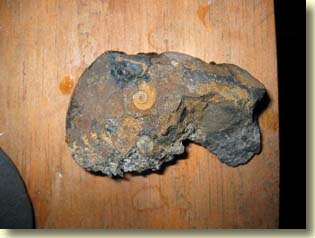 |
 |
| More remarkable salagrama silas. The first,
found by Martanda, was too large to carry with us, so we returned Him to
the Gandaki the next morning. He is literally smeared with gold and displays
five crystals in a semicircular pattern. The second, which I found, likewise
has a lot of gold and crystal in Him, is multicolored, and shows very fine
cakras. Then there is this nice Sesa sila supporting a Narayana sila. These
were found by Rasaji. She also found a white-faced Laksmi sila that is
not pictured. The Laksmi sila perfectly complements the Narayana sila on
the lap of the Sesa sila! |
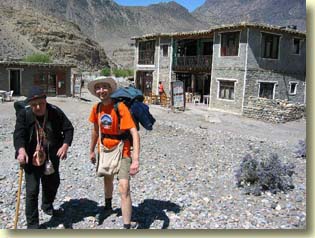 |
| The next morning we leave the Hotel Hill Ton on our
way to Muktinath. |
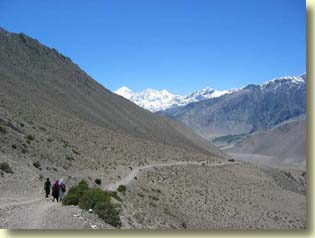 |
|
The trail to Muktinath carries
us out of the Gandaki River Valley into the soaring mountain heights. This
is not easy going. The air was thin to begin with, but now as we trudge
ever-higher in the hot sun under the weight of our backpacks, the decreasing
oxygen becomes more and more of a problem.
|
 |
| In less than half and hour, we look down upon Kagbeni
as if from an airplane. |
 |
|
During this season one meets
a good number of trekkers along the Jomsom-Kagbeni-Muktinath path. Americans,
Australians, Britishers, Europeans, and surprisingly a lot of Russians!
|
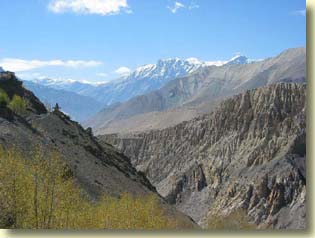 |
| The trail winds along the side of a steep valley formed
by a white-water tributary that rushes down to meet the Gandaki at Kagbeni.
In the cliffside opposite are many caves. The local Tibetan Buddhist monks
and nuns sometimes retire to these caves for meditation and austerity. |
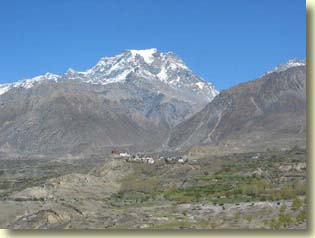 |
|
We approach the village of
Jarkot. If you look carefully you can see the dark red Buddhist monastery
perched on a hilltop at the edge of this village. It is 500 years old.
The Muktinath temple is about an hour's walk beyond Jarkot. On the top
of the mountain is the white lip of a glacier that feeds the Gandaki with
its icy waters.
|
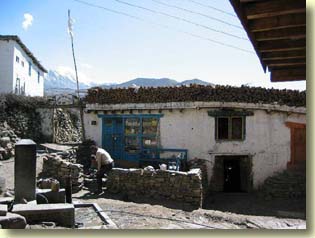 |
| This is what Jarkot looks like as you pass through. |
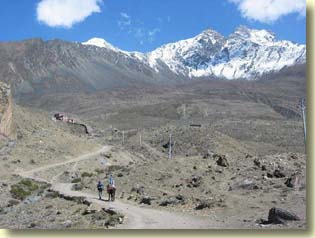 |
|
Having left Jarkot behind,
we are approaching the Dreamland Hotel, which is the first building visible
as one enters the village clustered at the foot of the hill of Muktinath.
That is Rasalila dd on the horse. She and I found it necessary to rent
horses to reach Muktinath. Her excuse is that she has a woman's body. Mine
is that my present body is different from the one I had when I hiked up
here in 1987.
|
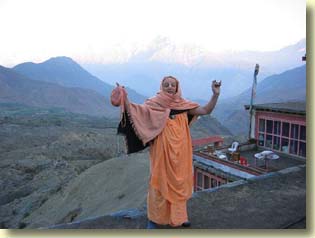 |
| Early next morning I chant japa on Dreamland's rooftop. |
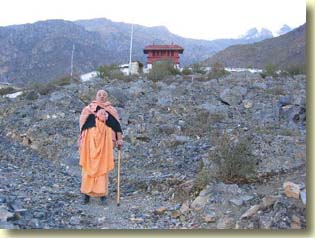 |
|
Now we are approaching the
Muktinath Temple complex. The dark red structure behind is the entrance
gate.
|
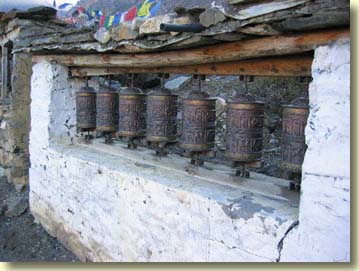 |
| Buddhist prayer wheels at the entrance to the Muktinath
complex. These revolvable cylinders are a common sight in Nepal. They are
inscribed with the Tibetan Buddhist mahamantra Om Mani Padme Hum--"Aum!
The jewel in the lotus! Hail!" The jewel is the pure spirit soul and the
lotus is the purified body of the true follower of Buddha's way. Tibetan
Buddhist turn these prayer wheels to earn merit. Simply pushing on them
to get them revolving is supposed to be as good as chanting the mantra
as many times as the wheel then revolves. |
 |
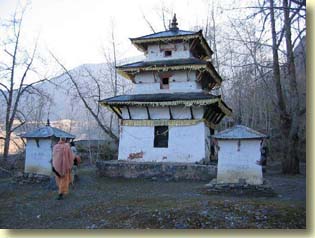 |
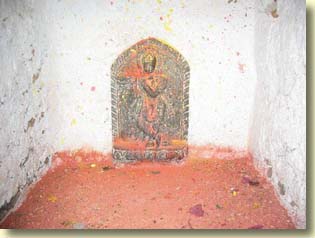 |
| Having passed through the entrance gate,
we proceed to the complex's first shrine. Muktinath is sacred to both Vaisnavas
and Buddhists. In this shrine we take darsana of Sri Krsna. To my knowledge
this murti of Lord Krsna is situated at a higher altitude than any other
Krsna Deity in the world. |
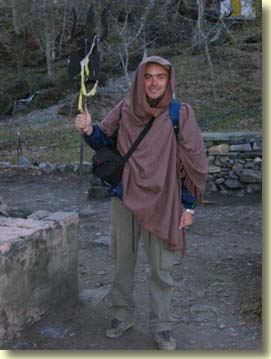 |
|
Rocana found this trisul
(symbol of Lord Siva) and poses as if he were a Shaivite sannyasi.
|
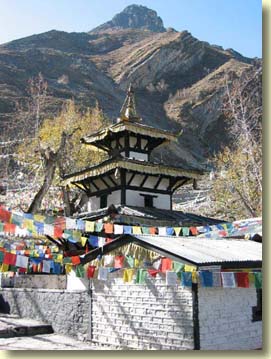 |
| This is the Muktinath Temple proper. Lord
Muktinath is, for Vaisnavas, Sri Padmapani (the form of Lord Visnu from
whose lotus feet sacred waters flow). Tibetan Buddhists worship Him as
Adi-Buddha. Lord Muktinath's form is manifest in brass. In bodily shape
and posture He resembles the Yoga Narayana Deity that you may see in the
April 2004 In2-MeC photoreport about Bhuvara Nrsimha temple in Halsi, Karnataka.
Atop the hill behind the Muktinath Temple is a Buddhist shrine. Incredibly,
some Buddhist nuns who serve at Muktinath daily climb this hill to also
perform worship up there! |
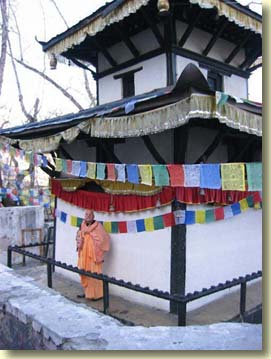 |
| Though we took a long darsana of and chanted japa
in circumambulation around Lord Muktinath, we unfortunately could not take
a photograph of the Muktinath Deity. |
|
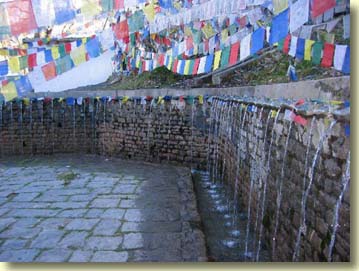 |
| Jutting from the stone wall that encloses Muktinath
Temple on three sides are 108 gomukhs or cows' mouths. From each mouth
icy glacial water flows. The water is considered as pure as the Ganges,
which flows from Gomukh in the Indian Himalayas. |
|
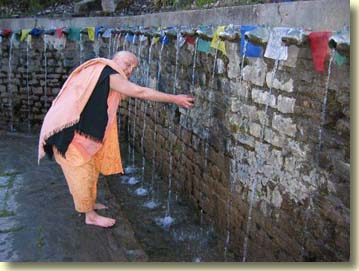 |
| The new salagram silas take Their morning bath! |
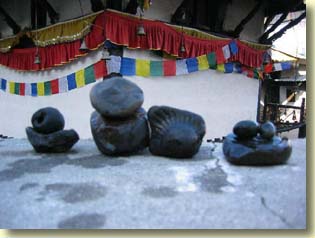 |
| After bathing, They are warmed by the morning sun... |
 |
|
...which streams from the
Eastern mountaintops through the fluttering prayer flags.
|
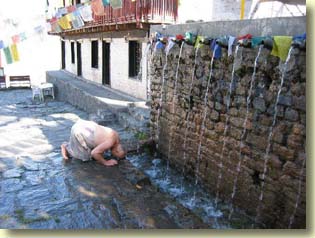 |
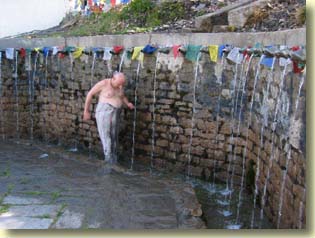 |
| Now that Their Lordships are bathed, it's
my turn! Believe me when I tell you this water, sacred though it may be,
is seriously cold! |
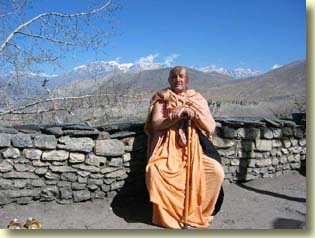 |
| Here we sit outside yet another shrine in the Muktinath
complex. |
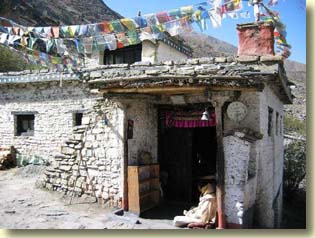 |
|
Inside this shrine one can
observe blue flames that spring from the mountain rock along with a stream
of water. We have a photo of the fire but it is so dark there's no use
publishing it here. It is said that at this spot at the time of creation
Lord Brahma made an offering of the five elements (earth, water, fire,
air and ether) to Lord Muktinath.
|
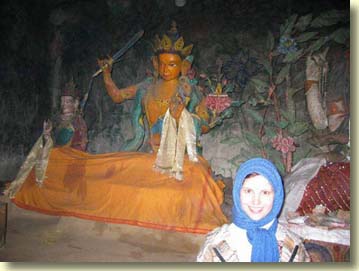 |
| Rasaji stands before a Buddhist deity within the fire-water
shrine. The flames are to be seen through openings in the base of the altar. |
|
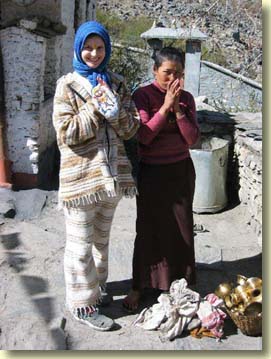 |
| Extraordinary women! The adventurous Rasalila dd,
who is one of the the few if not the only ISKCON woman to have visited
Muktinath, stands alongside a hardy Tibetan Buddhist nun. |
|
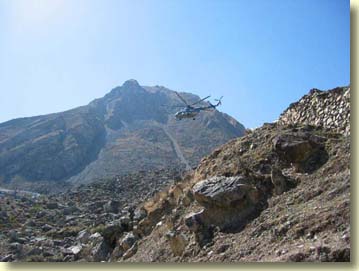 |
| As we left Muktinath Temple we observed this helicopter
coming in for a landing there. Must have delivered some VIP (Very Important
Pilgrims) eager to take darsana! |
|
 |
| Back down in the Gandaki River Valley again, we approach
Jomsom. |
|
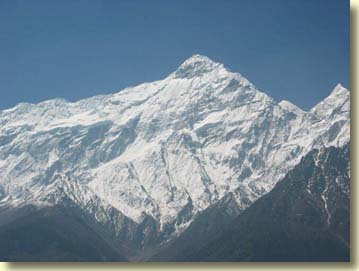 |
| The tremendous Nilgiri peak overlooking Jomsom. Mountain
ranges like the Rockies in North America and the Alps in Europe do not
prepare you for the stupendous size of these Himalayan mountains. |
|
|
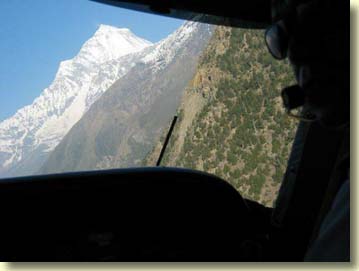 |
| Back aboard the Cosmic Airways Dornier, we zip between
the mountains to Pokhara. |
|
 |
|
During our return to Pokhara
we visited the Sheti River Gorge. The water racing through the rocks is
not only white with foam, it is naturally white even when taken up in a
bucket from the river. Thus the name Sheta, which is derived from sveta,
Sanskrit for "white."
|
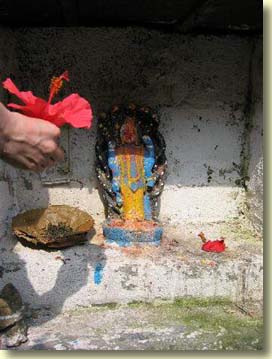 |
At the Sheti River Gorge is this little
temple to Lord Vasudeva-Krsna.
|
And that's the end of the Pilgrimage to Shalagram photoreport!

The contents of this web
site must not be reproduced without prior permission of the author.
Copyright © 2003-2004
We are grateful to be able to copy and use these three pages with
the direct permission of HH Suhotra Swami 16th May 2004
parts 1 - 2
- 3
|
